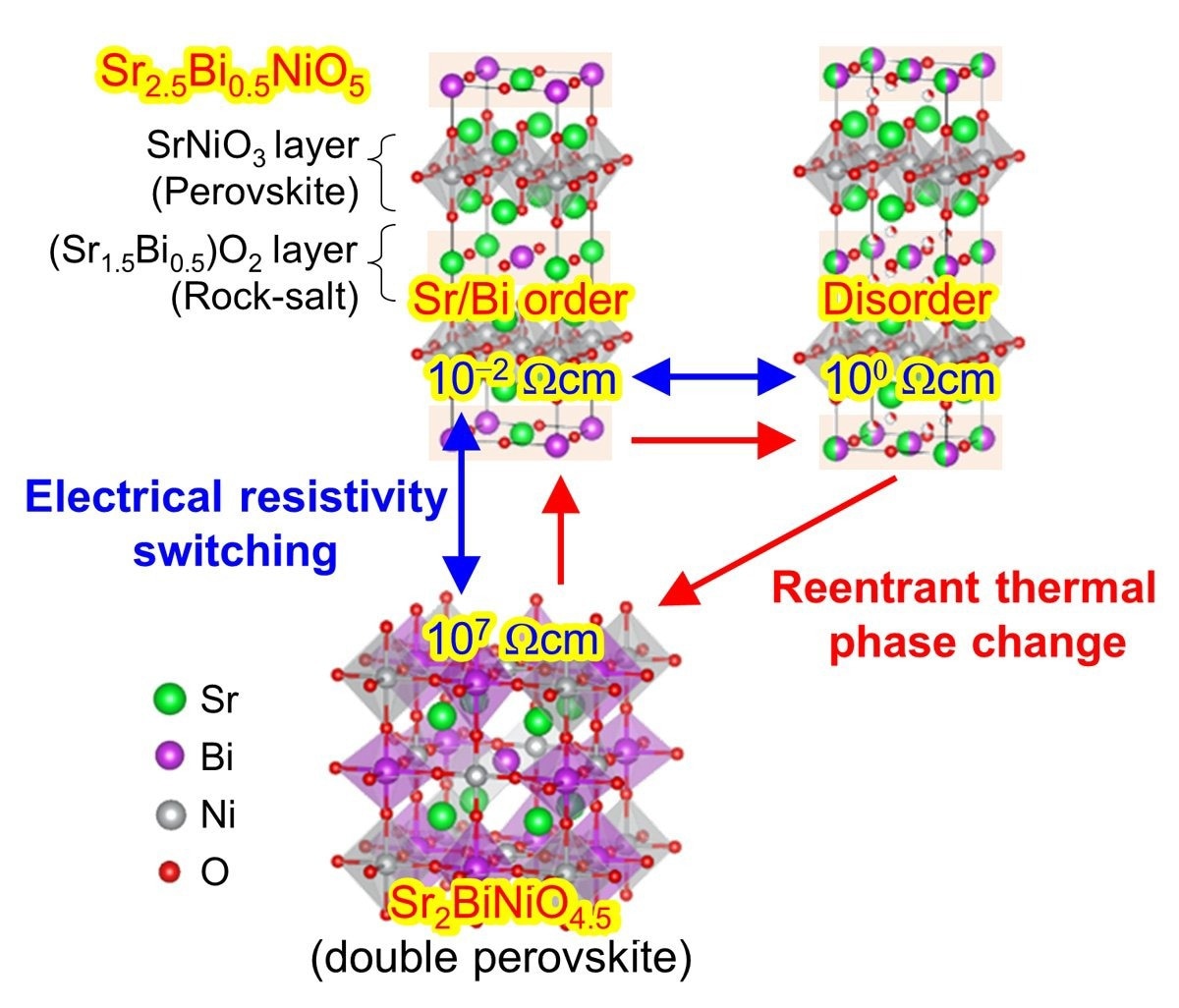A significant milestone has been reached in the advancement of non-volatile phase change memory, a form of electronic memory capable of retaining data even when power is disconnected, in a material that had not previously exhibited the necessary characteristics for such memory.

Schematics of electrical resistivity switching and reentrant thermal in Sr2.5Bi0.5NiO5. The top two figures are the crystal structures of Sr2.5Bi0.5NiO5 with different Sr/Bi arrangements. The bottom figure is the crystal structure of double perovskite Sr2BiNiO4.5. The Blue value denotes the electrical resistivity of each nickel. Image Credit: ©Hideyuki Kawasoko et al.
Historically, phase change memory predominantly relied on chalcogenides, a group of materials recognized for their ability to undergo reversible electrical transformations as they shift between their crystalline and amorphous states.
In a recently disclosed research report, scientists describe an intriguing thermally reversible alteration in room-temperature electrical resistivity observed in layered nickelate materials, suggesting the possibility of enhanced performance and increased sustainability.
The findings were published in the journal Advanced Science on September 3rd, 2023.
Layered nickelates represent a category of complex oxide substances featuring nickel ions. They possess a layered structure in which planes composed of nickel and oxygen atoms are interspersed with layers containing other elements, often alkaline-earth or rare-earth elements.
This distinctive layered configuration has captured the attention of researchers due to its fascinating electron properties, with potential applications spanning areas like superconductivity and, in this instance, electronics.
The layered nickelate investigated by the researchers is specifically comprised of strontium, bismuth, and oxygen atom layers arranged in a “rock salt” structural configuration. These layers are alternated with layers containing strontium, nickel, and oxygen atom molecules arranged in a perovskite structure.
Perovskites are characterized by a distinct crystal structure featuring two positively charged atoms and one negatively charged atom, and they possess a range of captivating properties, including superconductivity and ferroelectricity—a natural electric polarization that can be inverted by applying an electric field.
This latter property is particularly relevant to non-volatile phase change memory, which is based on a material’s ability to switch between two states of electrical resistivity reversibly.
We wanted to know if a similar reversibility could be achieved thermally.
Hideyuki Kawasoko, Study Co-Author and Materials Scientist, Tohoku University
This kind of reversibility has previously been demonstrated in various chalcogenides, which are compounds composed of elements from group 16 of the periodic table, including sulfur, selenium, and tellurium. However, it has not been observed in transition metal oxides, which are compounds formed by oxygen and elements typically found in the middle section of the periodic table, specifically within groups 3 through 12—until now.
This distinction is significant because while chalcogenides have already proven effective for numerous phase-change memory applications, transition metal oxides often exhibit superior thermal and chemical stability compared to certain chalcogenides. This potential advantage could result in devices with extended lifespans and the ability to function effectively in more challenging environmental conditions.
Additionally, numerous transition metal oxides are more plentiful than chalcogenides, a factor that can contribute to cost reduction and enhanced sustainability. Furthermore, transition metal oxides are already extensively utilized in electronics, sensors, and related fields. Should they prove adaptable to novel functions, such as phase change memory, it could streamline their incorporation into existing manufacturing procedures and devices. This, in turn, may further streamline the supply chain, potentially leading to additional sustainability benefits.
The scientists discovered that the specific layered nickelate they examined undergoes a thermally reentrant crystalline phase change. This phenomenon refers to a unique type of phase transition in which the material undergoes a reversible transformation between three distinct crystalline phases as it is heated and subsequently cooled.
Basically, the material can switch back and forth between the three phases multiple times as it is heated and cooled.
Tomoteru Fukumura, Study Author, Tohoku University
This stands in contrast to the typical phase change, which is irreversible and takes place only once as the material is either heated or cooled. The significance of the thermally reentrant phase change observed in the layered nickelate during the study lies in its capacity to facilitate the reversible alteration of electrical resistivity, particularly at room temperature.
This characteristic opens the door to the development of multi-level non-volatile phase change memory utilizing this material for a variety of everyday applications.
Furthermore, the study shed light on the specific mechanisms responsible for the reversible transformation of room-temperature electrical resistivity. These findings could have far-reaching implications for devices relying on non-volatile memory, extending well beyond the scope of this particular material explored in the study.
Journal Reference
Matsumoto, K., et al. (2023). Thermally Reentrant Crystalline Phase Change in Perovskite‐Derivative Nickelate Enabling Reversible Switching of Room‐Temperature Electrical Resistivity. Advanced Science. doi.org/10.1002/advs.202304978.